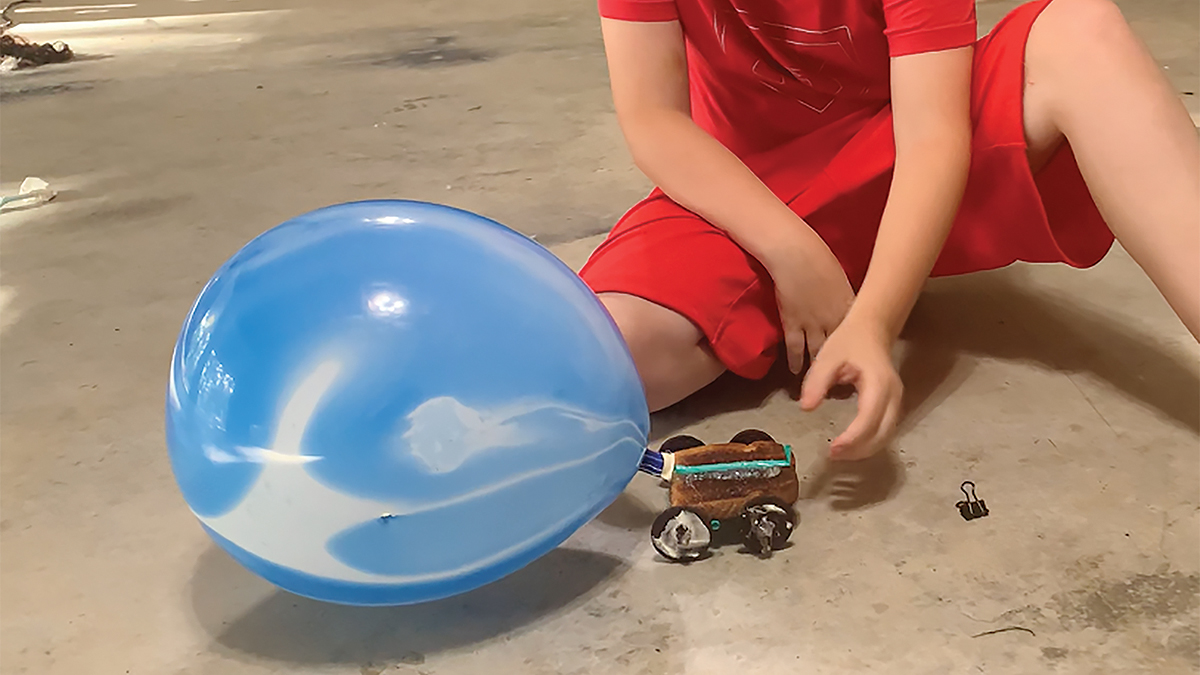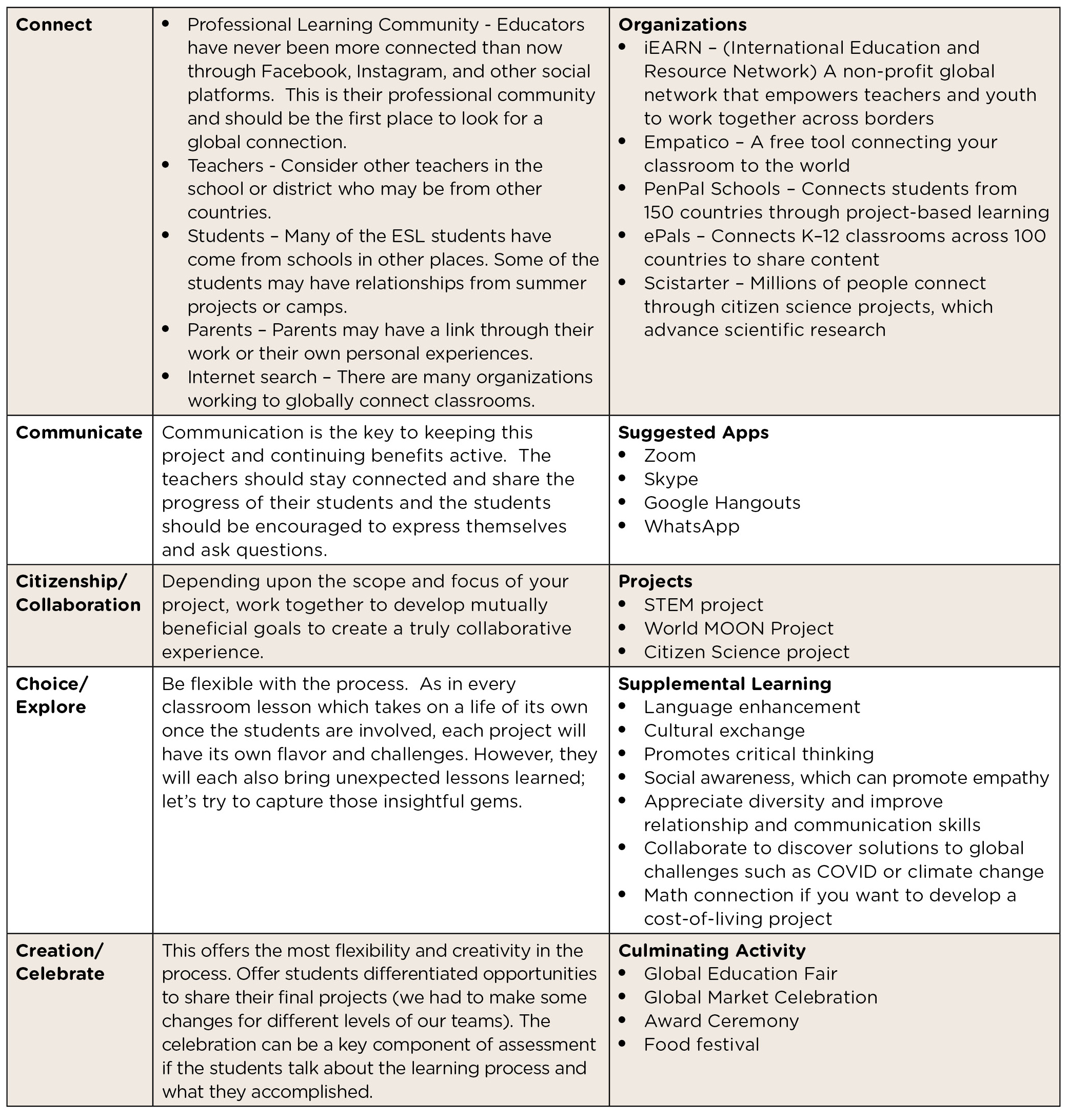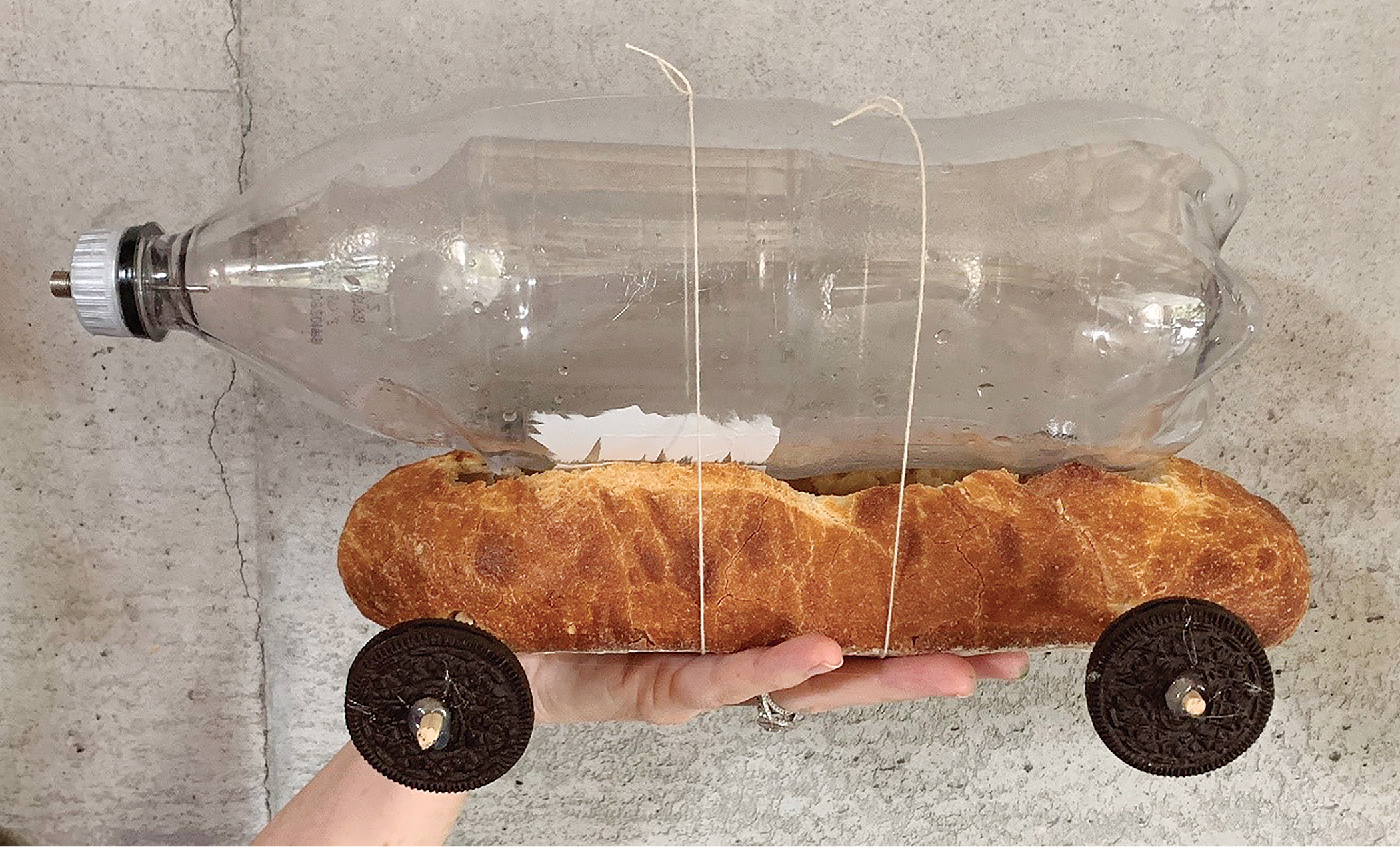feature
Where in the World?
A Mars Rover globally collaborative STEAM project
Science and Children—July/August 2021 (Volume 58, Issue 6)
By Shazia Iqbal, Jocelyn Miller, and Walter Smith

What if boundaries ceased to exist? Instead of each country, city, or district viewing the world as “us” against “them,” the world was united. We collectively became one team. The “we” became Mother Earth, and the “them” were all the factors detrimental to the balance of life? If 2020 has taught us anything, it is that people need each other. When we were forced to isolate ourselves physically, many new connections sprung up through the ubiquitous vein of the internet. Let us promote this newfound global oneness and nurture it to facilitate global education to develop a new language. This new language can foster global connections by applying STEAM instruction as a channel to promote a holistic approach to education and make way for a global citizenry as students and educators collaborate to discover solutions to the most pressing worldwide issues. If we teach kids to view the world through a global lens from a young age, it will create a lasting impression and make them use a global perspective to seek solutions to society’s everyday issues. This is a STEAM-based activity collaboration for grade 5 students for the first stamp on the global citizenry passport. We successfully implemented this activity with grade 5 students in Sao Paolo, Brazil. It can be adapted to different grades and places, depending on the teacher’s preference and location of the international partnership.
The Mission
This activity was undertaken by a fifth-grade teacher in rural America, working with a group of about eight students and their teacher from a school in Sao Paolo, Brazil. The students in the United States were working on a unit about matter and identifying materials through observations and measurements. A focus on engineering practices facilitated the global collaboration. The mission was to build a rover that will be able to travel on Mars. The activity was executed remotely with the goal of promoting a shared collaborative partnership between the American and Brazilian teams. The teams from two different locales (it could be in a different district or country) need to share ideas to make a prototype that will travel for at least one meter. The object is for them to create the same rover within each group through their discourse. To further encourage cultural exchange and promote eco-friendly and affordable construction, they were encouraged to use recyclable materials. However, since this project was undertaken during the COVID-19 pandemic and there were constraints in movement and materials were limited, some students chose to use leftover food items. Since they used these materials, it was not possible to make identical rovers, so they followed the design of the prototype model instead. Under any other circumstances, the teams can determine which types of materials they will use, keeping cost in mind.
Seven-Step Approach to Global
If we want our students to seek to understand through a global lens, we must mediate and model such experiences. This goal motivated us to search out a willing global partner to collaborate with for the activity. This STEAM-based activity was designed for grade 5 students residing in Houston, Texas, and São Paolo, Brazil, but can easily be adapted to students of different academic levels and geographical location. In developing the unit, we utilized the following seven-step approach for transforming teaching and learning by using current pedagogy, technology, and global education (Lindsay and Davis 2013).
Making Global Connections
Educators interested in developing a global collaboration for the first time can find connections through students or diverse colleagues, professional contacts obtained during educational conferences, or community groups such as Rotary International. Additional resources for bridging international partnerships are provided in Table 1.

Science: Study the similarities and differences of the surface and climate of Earth and Mars. Understand the conditions necessary for life to exist. Discuss whether life can exist on Mars or any other planet besides Earth. Explore matter, chemical changes, and forces and interactions.
Technology: Use the engineering design process to develop a viable vehicle that can drive across Mars. Use the computer to research Mars’ environment and surface and use the internet to connect with the global partner using Google Hangouts or Zoom. ESL and special needs learners also benefit from translation programs online.
Engineering: Use the engineering design process to develop a viable vehicle that can drive across Mars. (Define the problem, conduct research to gather ideas for the solution, build a prototype, test, evaluate the prototype, communicate the design, and redesign to improve.)
Arts and Humanities: Students can draw their design and research their globally connected culture and history. The students can also keep a journal and be required to use the grade 5 high frequency in their writing.
Math: Making time zone calculations in order to meet at the same time. We did have some miscalculations, which meant that the meeting was missed and then rescheduled. Taking measurements of the car and measuring the distance it travels.
Communication
Before the first meeting, the students should locate their partners on a map. Time zones are crucial factors to consider when selecting a global partner. Together, determine the best form of communication and videoconferencing. Understand that mishaps in meeting times and technical difficulties can occur. We found it easiest to select one day and time for the weekly 20- to 30-minute meetings. To break the ice, it helps to learn to greet your partners in their native language. Our partners spoke Portuguese as their first language but were studying English as a second language, so communication took place in English.
Citizenship
The criteria set forth was to create a recyclable rover that would minimize waste and reduce cost. Due to the restrictions imposed by COVID-19, the students could use leftover food at home. This situational improvisation added a dimension to the project that encouraged student discussions around their favorite foods, which is often at the heart of many cultures and customs.
Contribution and Collaboration
An innovative model of co-constructive collaboration was emphasized based upon the Student Global Interdependence in Science Continuum (SGIS) (Smith 2021) seen in Figure 1. Every effort was made to maintain each student’s and team’s autonomy to promote the construction and exchange of knowledge. Cooperating as peers gave some reserved students the confidence to express themselves, and it also made each one of us more aware of the circumstances and resources available to our counterparts.

Choices
The students were encouraged to ask questions about the project and share their own ideas in determining the space and place of learning. This increased their motivation as they became the driving force and enhanced the success of the collaboration. Teaching content through the global education pedagogical tool promotes retention, ongoing learning, and fostering habits that nurture critical thinking.
Creation
Creation is the most advanced culmination of knowledge acquisition and the highest order in Bloom’s Taxonomy. Co-creating a product not only promotes higher-order thinking, doing it in global partnership supports 21st-century essential skills. The modern—and future—work environment demands globally harmonized strategies, solutions, and teamwork across borders and time zones. The teams develop a prototype and test the assumptions of the project requirements. If met, they communicate and proceed to share, if not, they redesign and refine the prototype.
Celebration
Celebration is often considered frivolous and dismissed to save time and swiftly ease into the next task, yet skipping this step overlooks the opportunity to collectively reflect and enhance personal and team growth. As students share the challenges and accomplishments they encountered during the process, they build interpersonal skills as well as self-confidence. It also encourages habits of excellence as the students are celebrated in front of their peers and teachers.
Special education disclosures vary overseas, therefore there was no mention of any student with a special need. There were ESL learners, so the Brazilian teacher made sure each team had one strong English communicator.
Meeting 1: Cultural Exchange
The first meeting is crucial in setting the tone of the partnership. Each team member will introduce themselves. Take the time for students to think about some questions they have about their partners’ home country, city, or district. This shows mutual respect and allows the students to learn geography with practical meaning. This meeting concluded with a weekly schedule for the recurring meetings and a group list for ease in communication. Students also started a general discussion about the project and agreed to come to the second meeting with a brainstormed list of ideas.
For ease of differentiating, the method of recording communications can be adapted to accommodate a student’s specific learning needs. An unexpected benefit of working online was that many students felt more comfortable sharing ideas in the chat box or through emails in writing as they could use Google translate to overcome the language barrier for students of varying abilities.
Meeting 2: The Beginning of a Plan
At the second meeting, everyone greeted each other as if we had been friends for a while. This cultural exchange is a salient lesson in promoting equity and tolerance, crucial in the recipe for global collaboration. During this meeting, we started discussing the project’s details, which was a natural segue to the engineering process. The students made a list of what they would need and some of the constraints in designing the rover. The meeting concluded with a table of needs and constraints, a responsibility assigned to each team member, and a list of web resources. The students struggled to find material that they both had access to for the rover. Discussions about stores closing and limited accessibility led to the idea of using leftover food items for the construction of their prototype.
Meetings 3 and 4: Collecting Information
During the next two meetings, the teams recorded their ideas and research in a table with a column for the Brazilian partners and one for the American partners. They shared some animations, videos, and drawings through links and screen sharing. Students were allowed to communicate using a teacher-approved email address to continue exchanging ideas outside of the videoconference meeting times. This proved to be quite beneficial as some of the students who were shy or experienced a language barrier felt more confident in sharing ideas through a short email. We were surprised by the enthusiasm and creativity expressed in the emails. Each meeting ended with a clarification of the ideas gathered and specific points for further research. Feedback was provided verbally during the discussions.
Brainstorm Meetings
In the following two meetings, the teams were asked to brainstorm how they imagined their rover could be produced. What is the design? How large will it be, and why? What materials will you use? How will it move without an external force? The ideas were recorded in their table. Some students brought drawings of a prototype, and some had lists of food items. Before moving into the create phase of the design process, the students each had to complete a rover design plan and list the items required. Since both partners had to make identical rovers, this was an excellent communication exercise. The US students found it amusing that the Brazilian students had some American favorite food items such as Oreos, which they were planning to use for the wheels. However, they were not able to reciprocate with a favorite Brazilian food snack, which gave the Brazilian students a chance to share their favorite local dishes. This got more of the students engaged in conversation and expanded their vocabulary for sharing ideas effectively.

Meetings 7–9: Create and Construct
Teams were building, testing a prototype, and redesigning their rovers through the experimental design. This was the most enjoyable aspect of the project as trial and error guided their inquiry and encouraged a sharing of ideas. Students quickly moved from making it a culturally significant vehicle to a practical one. The students kept notes of their challenges and improvements. The challenges and proposed design changes were shared during the meeting time. All the teams struggled with the power source for the rover and suitable material for the body. The favorite propulsion mechanism was the balloon rocket.

Meeting 10: Evaluate and Improve
Once the prototype was tested and improvements discussed, students were asked to sketch the improved version before creating the final model. As the teams were working remotely from home, one member of each team was chosen to assemble the final rover and test the mobility and distance travelled in their home. The test runs were recorded and shared with the group for feedback and amendments. For safety measures, they were supervised by their parents in their kitchens. The final model was shared during the last meeting and students were asked to reflect on the process of international collaboration in their engineering project. As a final assessment, the actual prototype, a final presentation, and a written report were used. This activity can be extended to focus more on the balanced and unbalanced forces or matter interactions as some idea for the propulsion of the rover.
During the last meeting, the social enrichment of the student collaboration shone through. The Brazilian students had improved their spoken English and gained confidence in expressing themselves to the American counterparts. In humility, the American students realized that their counterparts already spoke more than one language and, therefore, felt less arrogant. This paved the road to shared empathy for each other’s circumstances.
Conclusion
If our goal as educators is to prepare children for the real world and provide authentic learning experiences, this project is an ideal tool to teach global connections. We have experienced a world global connection during the pandemic like no other. In every country, every corner of the world was a part of the “practical experiment.” For years, we have aspired to make engineering more accessible and encourage students to pursue engineering careers. COVID-19 has engaged the world in STEAM. People are glued to social media, navigating data, looking at graphs, and learning about microbiology all to gain a deeper understanding of a virus.
STEAM, in the absence of global education connections, is not representative of the scientific enterprise. Just as the virus knows no borders, neither do discovery or innovation. Society will only succeed if we recognize that we are a collection of our individual stories and perceptions that will create a beautifully unique tapestry when woven together with guidance. Creative problem solving will tackle global challenges, and we as educators must prepare and encourage our students to charge forward with a global mindset. ●
Supplemental Resources
Download the student sheets, journal prompts, project specifications, and rubric at https://bit.ly/3iJHBaD.
Shazia Iqbal (shazia.iqbal@ttu.edu) is a global STEM educator and PhD student, Jocelyn Miller is a PhD student, and Walter Smith is a professor of education, all at Texas Tech University in Lubbock, Texas.
Aerospace Engineering Teaching Strategies Technology Elementary Grade 5


